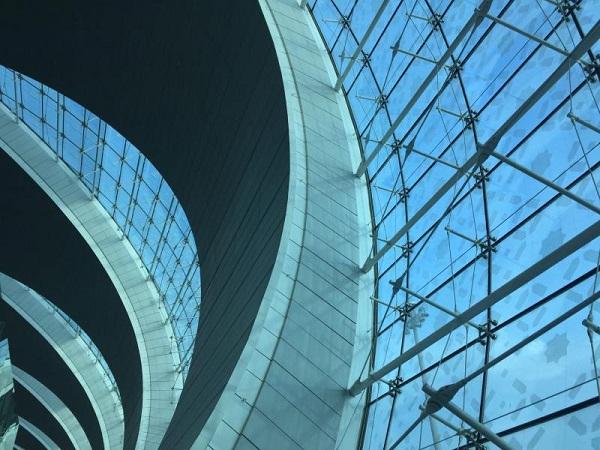Continued research and development, the best use of the latest technology and the experience of industry experts have opened up new dimensions in glass.
Such a common material is glass that it’s easy to forget we still don’t understand its full capabilities. Bent glass has been used in buildings since the early nineteenth century. But it wasn’t until the 1990s, with the development of the first horizontal tempering machine with a bending furnace, that bent tempered glass of sufficiently good optical quality became generally available. Still, there were quite a few limitations and constraints.
Many efforts have been made to improve the technology over the last years, to improve methods and techniques of processing tempered bent glass and also to process top quality.
The bending and tempering process in brief
Modern horizontal bending and tempering lines commonly operate like this:
- The flat glass is first heated to over 630 °C − until red hot.
- Once heated, the glass is moved within the furnace into the bending station, where it is bent to its target radius.
- The glass can be twisted into the direction in which the glass flows, which is known as lengthwise bending.
- It can also be bent crosswise across the glass flow, which is called crosswise bending.
- The bent glass is then tempered by cooling to trap high energy forces within the glass.
- The bent and tempered glass comes out of the furnace.
It’s fair to say the main stages of this process have not changed much since the 90s. But technologies have.

Bent tempered glass is welcome for a reason
There are several other common methods for curving or bending glass. These include hot bending, lamination bending, bending and tempering and cold bending. However, only the bending and tempering method has the advantages that make it so attractive to modern architects and designers.
First of all, tempered curved glass is safety glass. When broken, it is harmless to people. Therefore, where a high degree of safety is required, such as in windows, curtain walls, balustrades or skylights, it becomes the most practical type of curved glass.
Secondly, bent and tempered glass offers greater resistance to mechanical and thermal loads, as well as durability against temperature variations. In fact, tempered bent glass withstands up to five times more mechanical strain than bent annealed glass – again making it more useful from the contractors’ perspective.
Last but not least, bent and tempered glass is cheaper to produce than hot-bent laminated glass, since it’s done in a single process and doesn’t require lamination.
The ability to curve and temper glass simultaneously has helped to put glass material on a more advanced level, adding considerable value to the end product.
Bent glass brings elegance and energy to any designed space, whether it is an architectural building or just part of your latest home appliance. It gives an artistic focal point to natural light within interior spaces. But above all comes the assurance that tempered bent glass meets safety requirements. This is valued the most.
To discover more about the technology, read: Curved glass: an obstacle or opportunity in glass architecture?

Where we are today?
In general, the bending and tempering technique has advanced to a new standard today – far from what it was a decade ago. However, some constraints still do exist. These involve limits on maximum size, weight, glass thickness and also limitations with extreme forms.
For now, these constraints must be taken into account in the design of glass constructions. However, glass processing equipment manufacturers are challenging themselves to overcome them. And since technologies are evolving rapidly, they will soon completely reshape the process, allowing glass processors to reach beyond limitations.
For example, it’s now possible to temper and bend a much wider range of sizes and thicknesses, thanks to the latest achievements. Among them is an innovative machine that for the first time averts any optical issues – a problem of the past. Now, with correct technology, reaching a top-quality optical result from each run is no longer difficult.
What was considered a decade ago to be practically impossible is now a cost-effective and adaptable way of producing quality curved safety glass with minimal changeover time, no anisotropy issues and zero tooling. Now, machines are even available to soft-coat bent building glass.
The future of bent tempered glass
The interest in curved glass forms continues to grow. It will grow even more, once designers and architects understand the latest achievements in bending and tempering.
Bent tempered glass is no longer experimental. Thanks to ongoing R&D and the new technological transformations, custom bent glass is bringing the beauty of form with function to the designs and applications of tomorrow, creating new potential for the world of glass. It can be now a quality economical and safe material with tens of thousands of shapes.
The world is curved. So should be the glass − and our thinking. There is no excuse for forcing old flat glass designs, now that we can finally put our trust in curved forms.
See more about bent glass in practice: Use of hot bent glass. Case: 252 East 57th Street, New York























